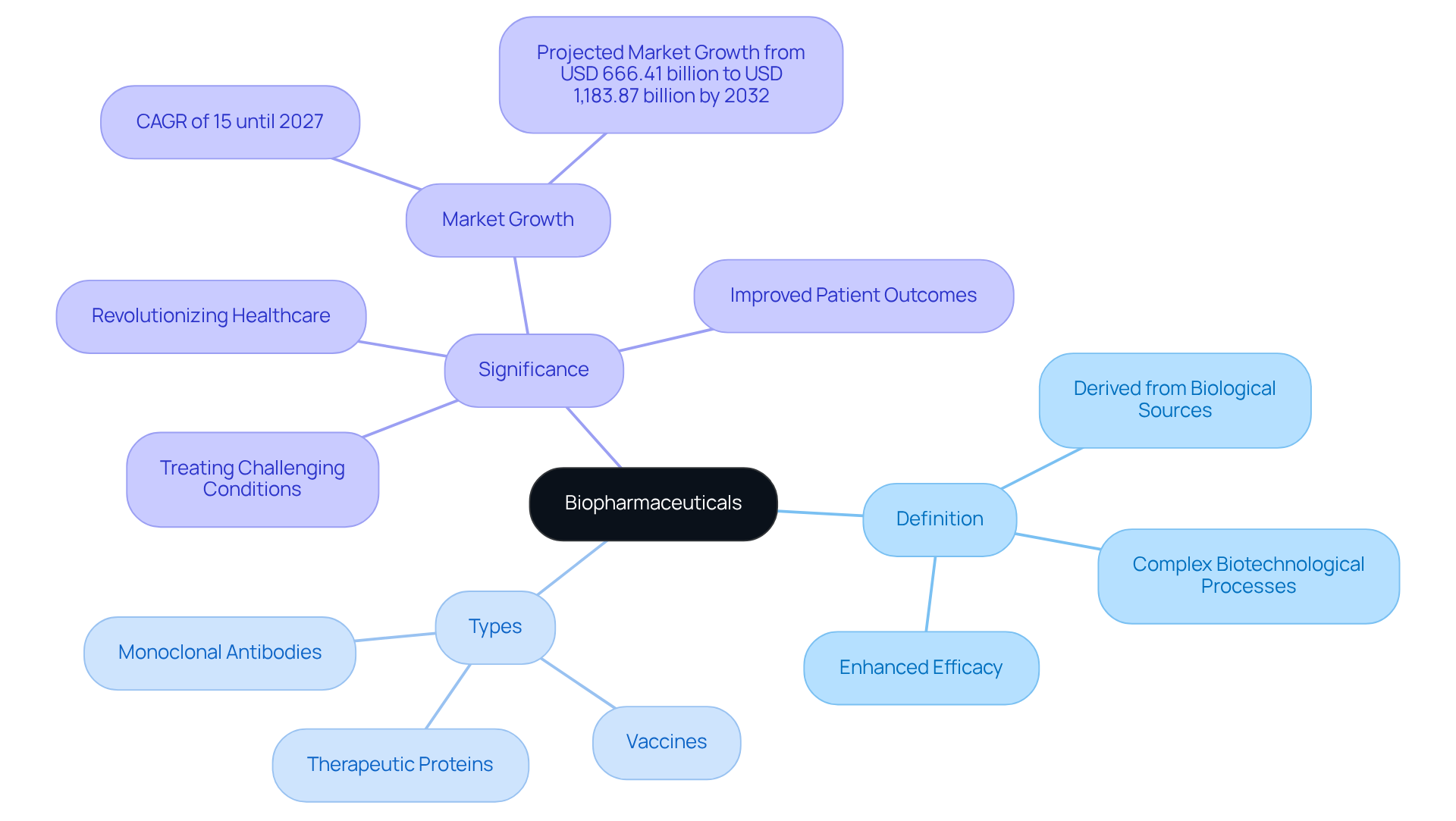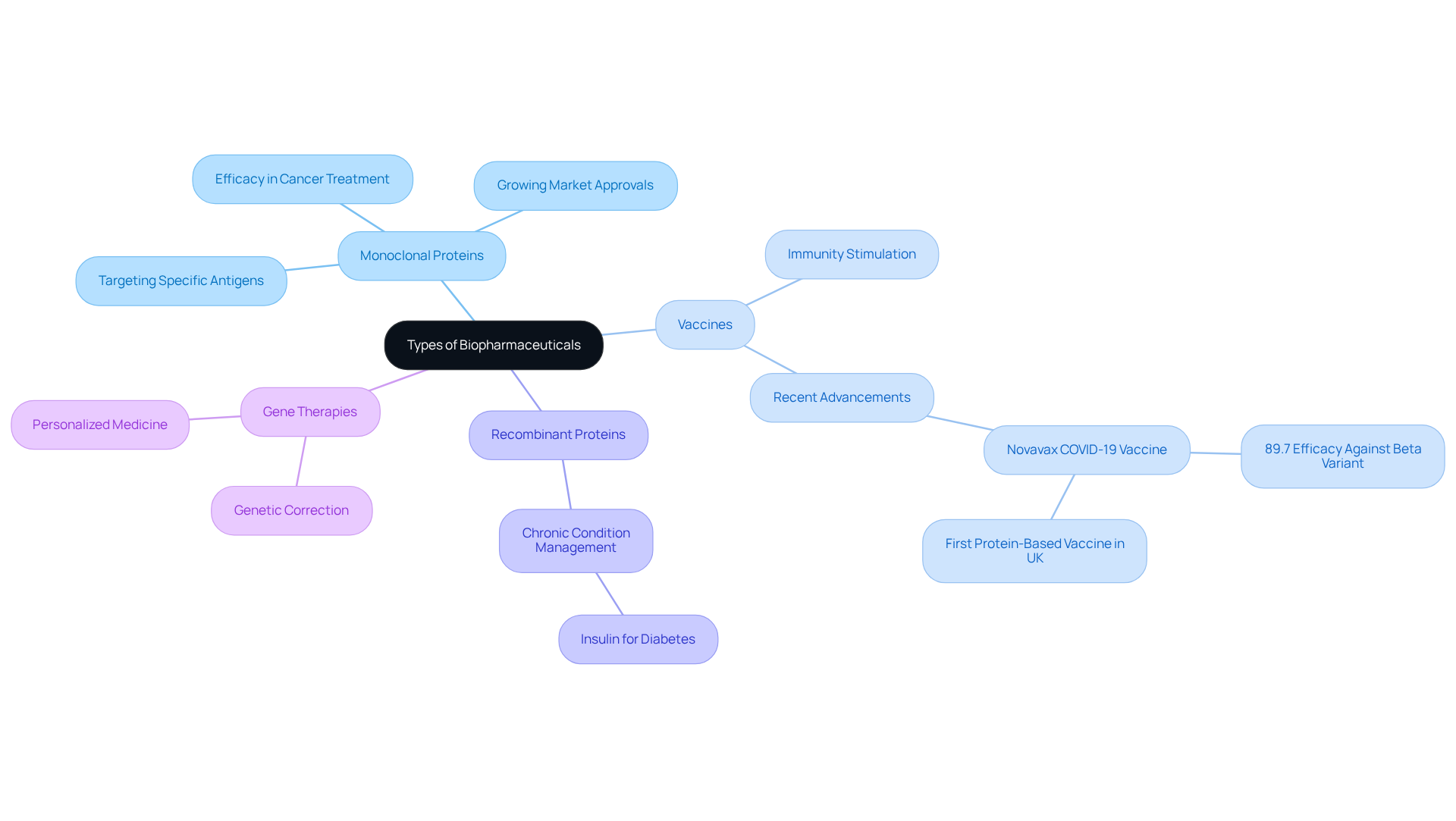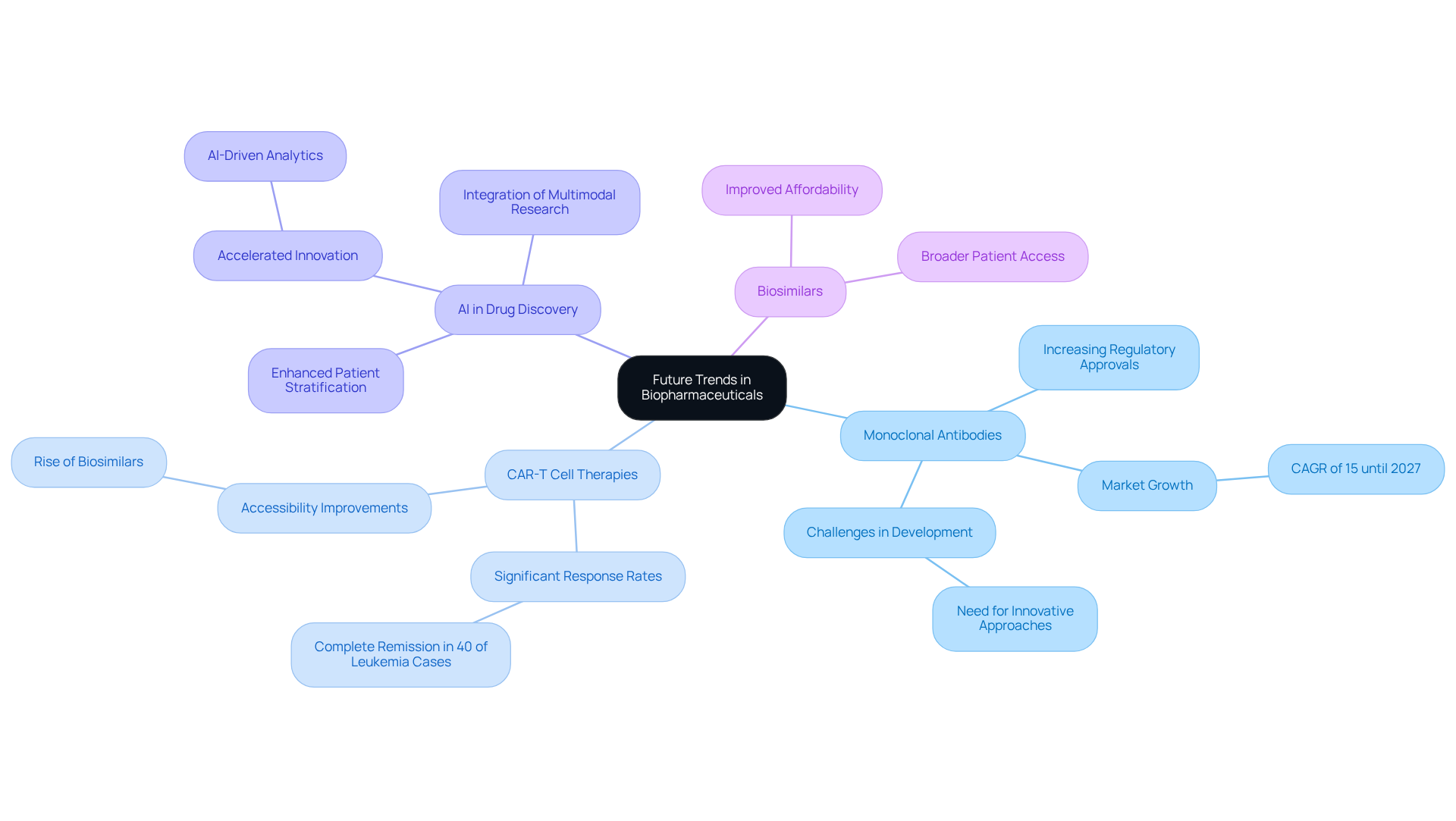Overview
Biopharmaceuticals, commonly referred to as biologics, represent a category of medicinal products derived from biological sources, including living cells and organisms. This diverse range encompasses critical products such as:
- vaccines
- therapeutic proteins
- monoclonal antibodies
Their significance in modern medicine cannot be overstated; these advanced therapies effectively address complex conditions that traditional pharmaceuticals often fail to treat. This capability is propelled by remarkable advancements in biotechnology and the growing field of personalized medicine, underscoring the vital role that biopharmaceuticals play in enhancing patient outcomes.
Introduction
Biopharmaceuticals, commonly known as biologics, represent a transformative class of medicinal products derived from living organisms, fundamentally altering the landscape of modern medicine. This article explores the intricate world of biopharmaceuticals, tracing their evolution from early discoveries to their current status as a multi-billion dollar industry.
We will highlight their diverse applications, ranging from vaccines to gene therapies. Nevertheless, as the sector continues to innovate, it encounters significant challenges, including escalating costs and the implications of emerging technologies.
What does the future hold for biopharmaceuticals? How will advancements in AI and personalized medicine reshape the treatment landscape? These questions are pivotal as we navigate this rapidly evolving field.
Define Biopharmaceuticals: Key Concepts and Significance
To understand what is biopharmaceutical, one must recognize that biopharmaceuticals, commonly known as biologics, represent a class of medicinal products derived from biological sources, including living cells and organisms. These encompass a diverse array of products, such as:
- Vaccines
- Therapeutic proteins
- Monoclonal antibodies
What is biopharmaceutical is that, in contrast to traditional pharmaceuticals which are chemically synthesized, they are produced through intricate biotechnological processes. This complexity often results in enhanced efficacy, particularly in targeting specific diseases. The significance of biopharmaceuticals is profound; they possess the capability to treat conditions that were once deemed challenging or even impossible to manage. This innovation has revolutionized healthcare, leading to improved patient outcomes and a transformative impact on medical treatment.

Trace the Evolution of Biopharmaceuticals: Historical Context and Milestones
The evolution of biopharmaceuticals commenced in the early 20th century with the groundbreaking discovery of insulin, marking a pivotal moment in biologic therapies. The 1970s ushered in recombinant DNA technology, facilitating the production of human insulin and various proteins. The approval of the first monoclonal antibody in the 1980s further accelerated the field, leading to a remarkable surge in biopharmaceutical development.
Today, the question of what is biopharmaceutical highlights its status as a multi-billion dollar industry, with continuous advancements in genetic engineering and personalized medicine paving the way for future innovations. However, the sector grapples with challenges such as rising healthcare costs and the implications of government negotiations on medication pricing, which are critical for understanding the current landscape.
Moreover, projections indicate that by 2025, 30% of new drugs will be discovered using AI, potentially revolutionizing drug development processes. As the most profitable industry globally, the pharmaceutical sector persists in its evolution, driven by both innovation and the imperative to tackle these pressing challenges.

Explore Types of Biopharmaceuticals: Characteristics and Applications
What is biopharmaceutical includes a diverse range of products, such as monoclonal proteins, vaccines, recombinant proteins, and gene therapies.
- Monoclonal proteins are engineered to target specific antigens, demonstrating notable efficacy in treating cancers and autoimmune disorders. The increasing approvals of monoclonal antibodies underscore their growing reliance in clinical settings, significantly contributing to market growth.
- Vaccines, conversely, play a vital role in stimulating the immune system to prevent infections. Recent advancements, such as the Novavax COVID-19 vaccine, have illustrated their effectiveness; this vaccine achieved an efficacy rate of 89.7% against the Beta variant of the virus and is recognized as the first protein-based vaccine registered for use in the UK.
- Recombinant proteins, exemplified by insulin, are essential for managing chronic conditions like diabetes, providing individuals with crucial treatment alternatives.
- Gene therapies aim to correct genetic disorders by introducing or modifying genes within a patient's cells, representing a cutting-edge frontier in personalized medicine.
The rising prevalence of chronic illnesses globally highlights the importance of genetic treatments in addressing these health challenges. Each type of biopharmaceutical, when considering what is biopharmaceutical, possesses unique characteristics that influence its application and effectiveness, emphasizing the necessity for ongoing research and innovation in this rapidly evolving field.

Anticipate Future Trends in Biopharmaceuticals: Innovations and Developments
The future of biopharmaceuticals, or what is biopharmaceutical, is poised for transformative advancements, driven by breakthroughs in biotechnology and personalized medicine. Among the most promising innovations are next-generation monoclonal antibodies and CAR-T cell treatments, which have demonstrated remarkable effectiveness in combating various cancers. Notably, CAR-T cell therapies have exhibited a significant response rate, with research indicating complete remission in over 40% of individuals with specific types of leukemia. As these therapies evolve, they are expected to become increasingly accessible, particularly with the anticipated rise of biosimilars, enhancing affordability and broadening patient access to essential treatments.
Artificial intelligence is also playing a crucial role in revolutionizing what is biopharmaceutical medicine discovery. By leveraging AI-driven analytics, companies can analyze extensive datasets to identify potential treatment candidates and refine the development process. This integration not only accelerates the rate of innovation but also improves the accuracy of participant stratification in clinical trials, ensuring that treatments are tailored to the appropriate individuals more efficiently.
Industry experts assert that the incorporation of AI into drug discovery represents not merely a trend but a fundamental shift that will redefine how therapies are developed and introduced to the market. As regulatory frameworks adapt to these innovations, the biopharmaceutical industry is positioned to expand its influence in addressing complex health challenges, ultimately leading to enhanced patient care and outcomes.

Conclusion
Biopharmaceuticals, commonly known as biologics, represent a revolutionary class of medicinal products derived from biological sources. Their distinctive production processes, grounded in biotechnology, facilitate targeted treatments that have significantly transformed healthcare and improved patient outcomes. Understanding biopharmaceuticals encompasses not only their definition but also their critical importance in tackling complex medical challenges.
The evolution of biopharmaceuticals is characterized by significant milestones, ranging from the discovery of insulin to the emergence of monoclonal antibodies and the development of personalized medicine. Key categories of biopharmaceuticals include:
- Monoclonal proteins
- Vaccines
- Recombinant proteins
- Gene therapies
These categories highlight their varied applications in managing chronic diseases and enhancing preventive care. As the industry progresses, the incorporation of artificial intelligence into drug discovery is poised to revolutionize the development process, making treatments more accessible and tailored to individual needs.
Looking forward, the future of biopharmaceuticals is promising, with innovations set to redefine therapeutic strategies and patient care. The expected rise of next-generation therapies and biosimilars aims to:
- Enhance treatment efficacy
- Improve affordability
- Increase access
As the biopharmaceutical sector navigates these advancements, it is essential to acknowledge its crucial role in shaping the future of healthcare, ultimately leading to improved health outcomes for patients globally.
Frequently Asked Questions
What are biopharmaceuticals?
Biopharmaceuticals, also known as biologics, are medicinal products derived from biological sources, including living cells and organisms.
What types of products are classified as biopharmaceuticals?
Biopharmaceuticals include a diverse array of products such as vaccines, therapeutic proteins, and monoclonal antibodies.
How do biopharmaceuticals differ from traditional pharmaceuticals?
Unlike traditional pharmaceuticals, which are chemically synthesized, biopharmaceuticals are produced through intricate biotechnological processes.
What are the benefits of biopharmaceuticals?
Biopharmaceuticals often exhibit enhanced efficacy, particularly in targeting specific diseases, and they can treat conditions that were once considered challenging or impossible to manage.
What impact have biopharmaceuticals had on healthcare?
The development of biopharmaceuticals has revolutionized healthcare, leading to improved patient outcomes and a transformative impact on medical treatment.




